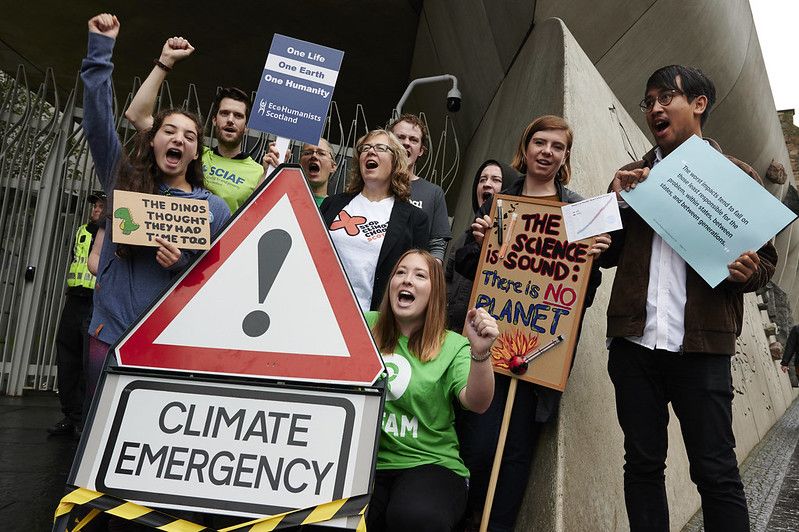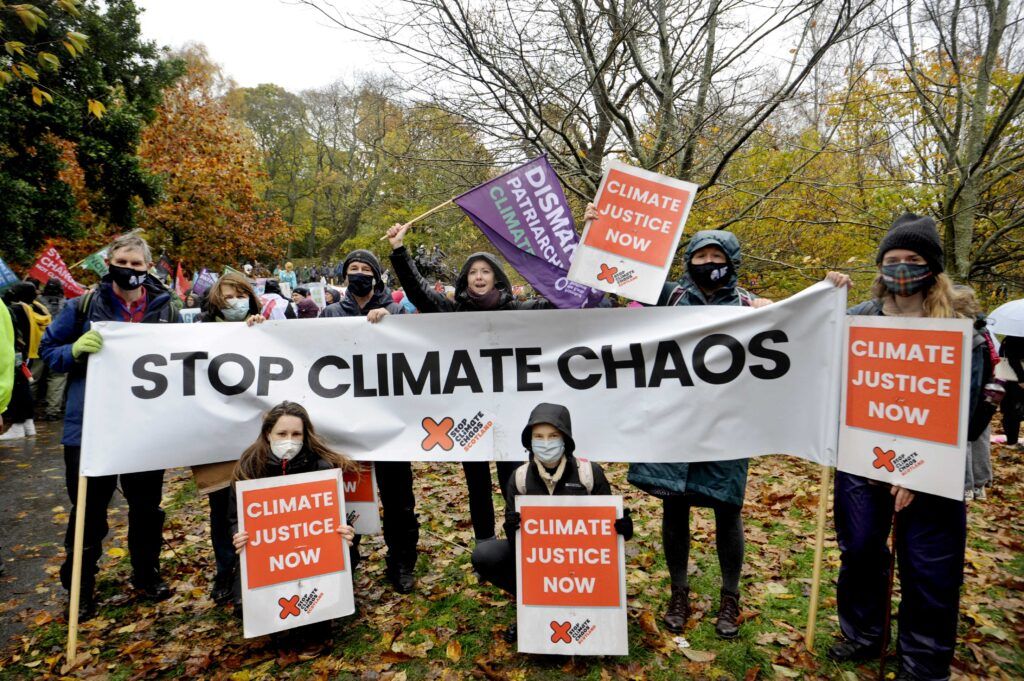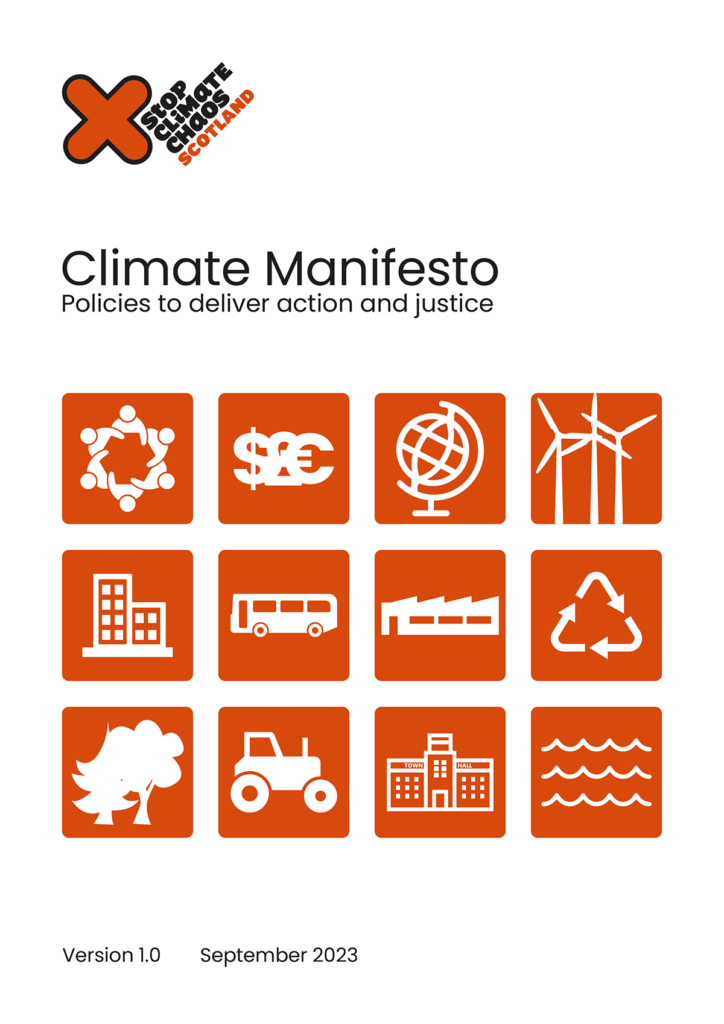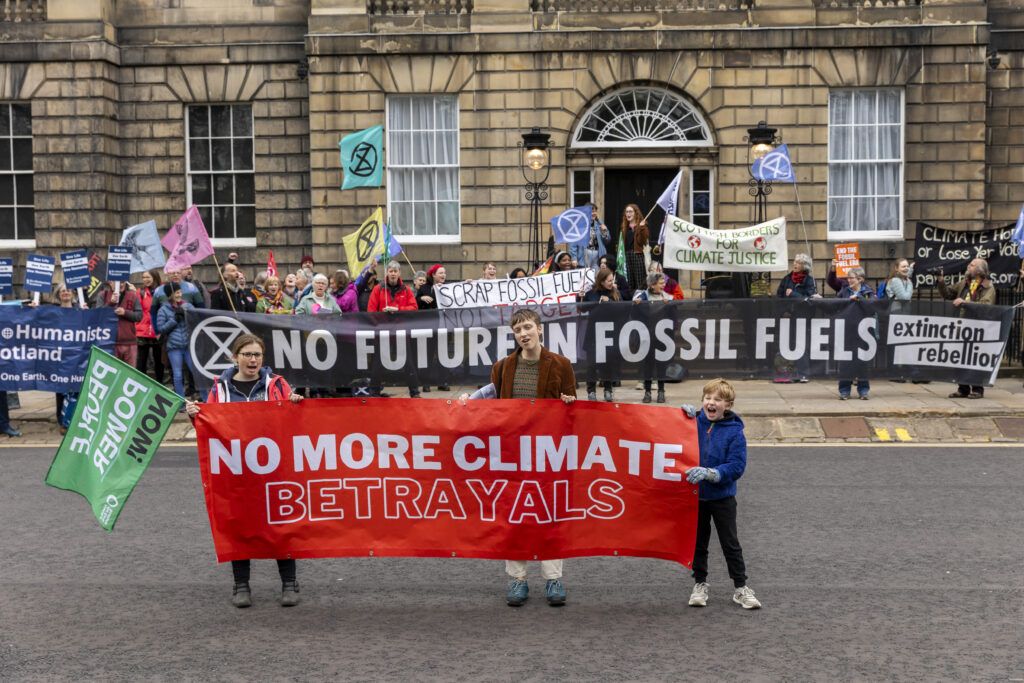Blog by Becky Kenton-Lake, SCCS Coalition Manager
2019 was the year that thousands of people joined the school strikers to march in towns and cities across the country, in an incredibly powerful display of concern, solidarity, and call for action. It was the year that the Scottish Parliament passed the Climate Change (Emissions Reduction Targets) (Scotland) Act 2019, committing to ambitious new legal targets to reduce emissions by 75% by 2030, and by net zero by 2045, with interim targets to hit in between. And it was the year that Scotland became one of the first countries in the world to declare a climate emergency.
Most of the climate movement was understandably pretty exhausted by years of campaigning to achieve the targets, but there was a huge amount of energy and hope about the prospect of meaningful climate action, especially with this huge wave of public momentum behind us.

COP comes to town
Hot on the heels of all of this, it was announced that Glasgow would host the UN climate talks, COP26, in 2020. With this hugely significant conference, as well as the world’s leaders, activists, scientists and media, coming to Scotland, it immediately became the focus of SCCS, and seemingly everyone in Scotland’s, work.
The eyes of the world would be on us, so wanted to make sure we delivered a full and diverse programme of events and support for visiting civil society and the Scottish climate movement, for the Scottish Government to show world leadership on what had been one of the biggest sticking points during COP negotiations – Loss and Damage, and to commit to the action needed to meet the recently set climate targets.
Build back better – or business as usual?
However, just months into our planning the pandemic changed everything. The government’s attention understandably switched to keeping people safe, and we saw a decisive shift onto emergency footing, with new laws passed in days, strong messaging rolled out, and no more business as normal. Whilst I sat in my living room trying to work out how to use Zoom, I watched as a truly emergency response was delivered by both the UK and Scottish government’s. While the response to the pandemic was in no way how anyone would want to see a transition to net zero delivered considering the negative impacts on people’s lives, jobs and wellbeing, it did show how previously slow processes can be expedited and urgent action taken to deal with an emergency situation.
During the pandemic, opportunities for a ‘green recovery’, or to ‘build back better’ began to become apparent. With people enjoying safer streets, cleaner air and a stronger connection to nature, this was the ideal time to put in place policies that continued these benefits. The way the green recovery could have been delivered was through the Scottish Government’s Climate Change Plan update (CCPu), published in late December 2020. This update needed to include policies that would deliver emissions reductions in line with the stronger targets in the 2019 Act. However, the Environment, Climate Change and Land Reform Committee, who scrutinised the update, made 166 recommendations for improvements and judged it to “lack sufficient policy detail, clarity on timescales and on where the largest challenges are across sectors”, that it “does not describe the detail of how emissions reductions will be delivered” and “relies too heavily on Negative Emission Technologies (NETs), with a lack of a contingency (Plan B)”. SCCS wholeheartedly agreed with the committee, saying that “detail is missing on how this plan will deliver genuinely transformative change.”
Despite the committee report and strong views of stakeholders about the need for improvements, the Scottish Government went ahead with the CCPu as it was originally published, blaming the impending 2021 elections – a huge missed opportunity, and one that set the course for a series of missed annual climate targets.
All is not lost – but it is damaged
The pandemic led to COP26 being delayed by a year, with the event finally taking place in November 2021. SCCS joined campaigners around the world in welcoming the Scottish Government becoming the first nation to commit funds to climate induced Loss and Damage, and we were pleased to play a small part in this, following years of campaigning by Global South activists. However, the success was bittersweet, as the Scottish Government did not take the opportunity of the COP spotlight to commit to enhanced measures to reduce emissions in Scotland. These issues are two sides of the same coin, and continuing to miss climate targets only means more funds are due to the most climate vulnerable countries to help them recover from the impacts – as summed up in our post COP26 press release.

Credit: Colin Hattersley
Planning for failure
In more recent times, SCCS’s focus has been on the Scottish Government’s development of a new Climate Change Plan (CCP), which was due to be published in November 2023, and was legally required to set out the policies and proposals that would ensure Scotland met its interim and 2030 climate targets. To try to ensure this one did not repeat the failings of the last CCPu, SCCS put forward over 100 proposals across different sectors in our Climate Manifesto, shared these at meetings with the Cabinet Secretary and then First Minister, and took part in a Climate Change Plan Advisory Group with other key stakeholders.

Issues began to emerge at the end of 2023 and into 2024: firstly, the CCP was delayed, and then the government’s advisors, the Climate Change Committee (CCC), published a damning report declaring the 2030 targets we had fought so hard for were “no longer credible”. It was deeply frustrating that after a long campaign for the targets, that were rightly ambitious due to our historic contribution to the climate crisis and resources available, these were judged no longer within reach.
It needn’t have been this way; if action to reduce emissions had started rapidly once the targets were set we could have been on track to meeting the 2030 target, using Scotland’s climate leadership to inspire others and enjoying the benefits of warm home, clean air and good green jobs.
The CCC report sparked a chain of events that we had to scramble to keep up with, starting with the announcement that the Scottish Government intended to scrap it’s 2030 target to reduce emissions by 75% and move from an annual targets system to 5 yearly carbon budgets, the end of the Bute House Agreement with the Scottish Greens, the resignation of First Minister Humza Yousaf and John Swinney becoming First Minister.

Amongst all of this, one thing was clear in our response: the Scottish Government abjectly failed to deliver an emergency to the emergency it declared. There has been a series of delayed policies, emphasis on warm words rather than action, and too much blame on the UK government. Opposition parties have often blocked positive policies, and the some parts of the media and others have turned climate into a culture war issue.
So, where does that leave us?
Scotland stands at a crossroads. The government has lost its climate leadership. Those in power must double down on efforts, and not cow to a vocal minority telling us reducing emissions is too hard, too expensive, or too much of a change to their lifestyles. After an exhausting few years, we need to retain our hope, and amplify the results of recent Climate Outreach research, and the Scottish Government’s own People’s Panel, which both clearly state that people in Scotland want leaders to get on with reducing emissions in a fair, supportive way, that also addresses poor health, poverty and provides jobs. The regular, consistent research showing the widespread support for climate action is reassuring and motivating – we still have an unstoppable force behind us, just like we did 5 years ago in the Meadows.
No one knows what the next 5 years will bring – although more change is certain. One of these must be the dramatic scaling up of climate action and a shift to a truly emergency footing.

